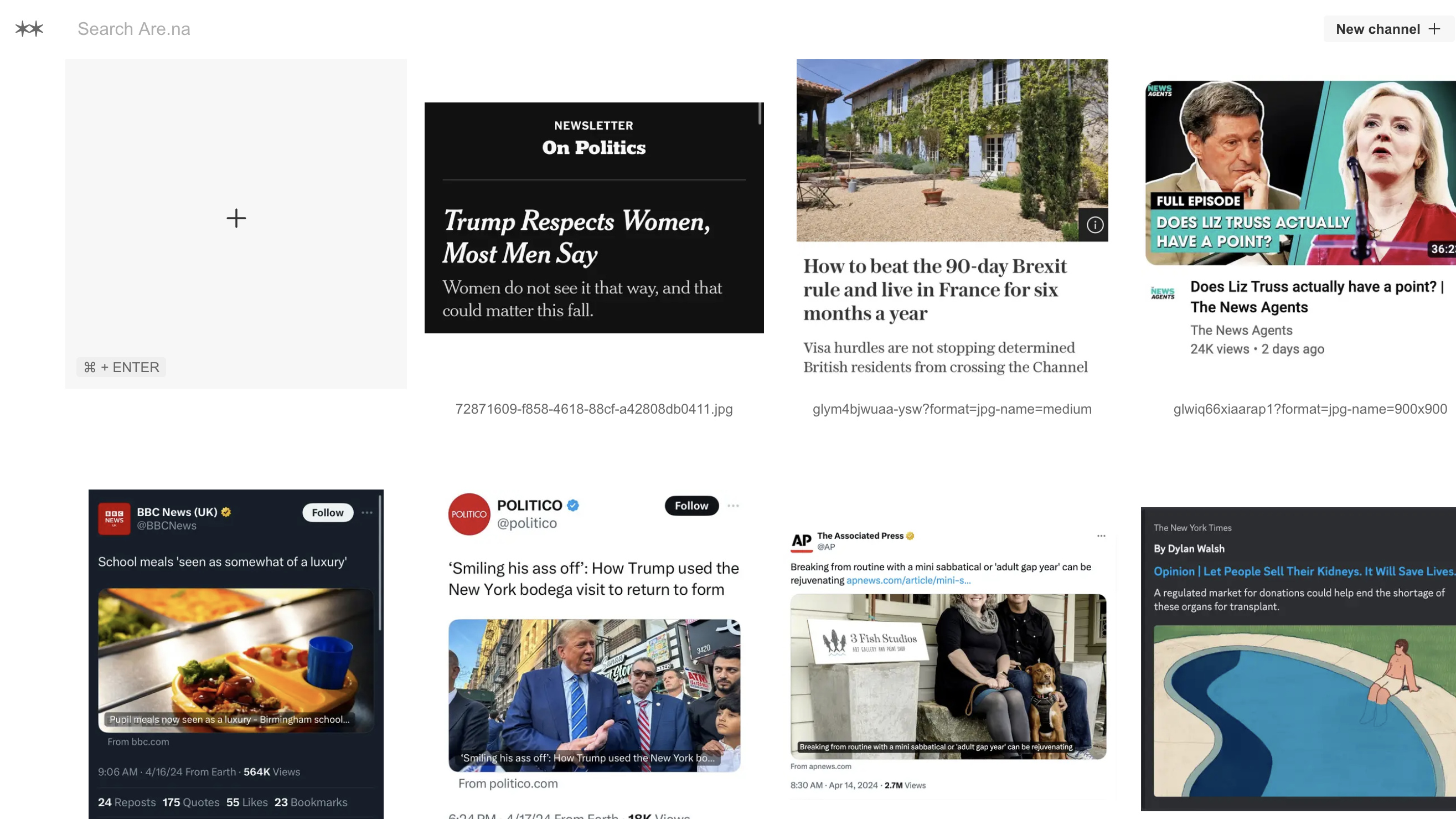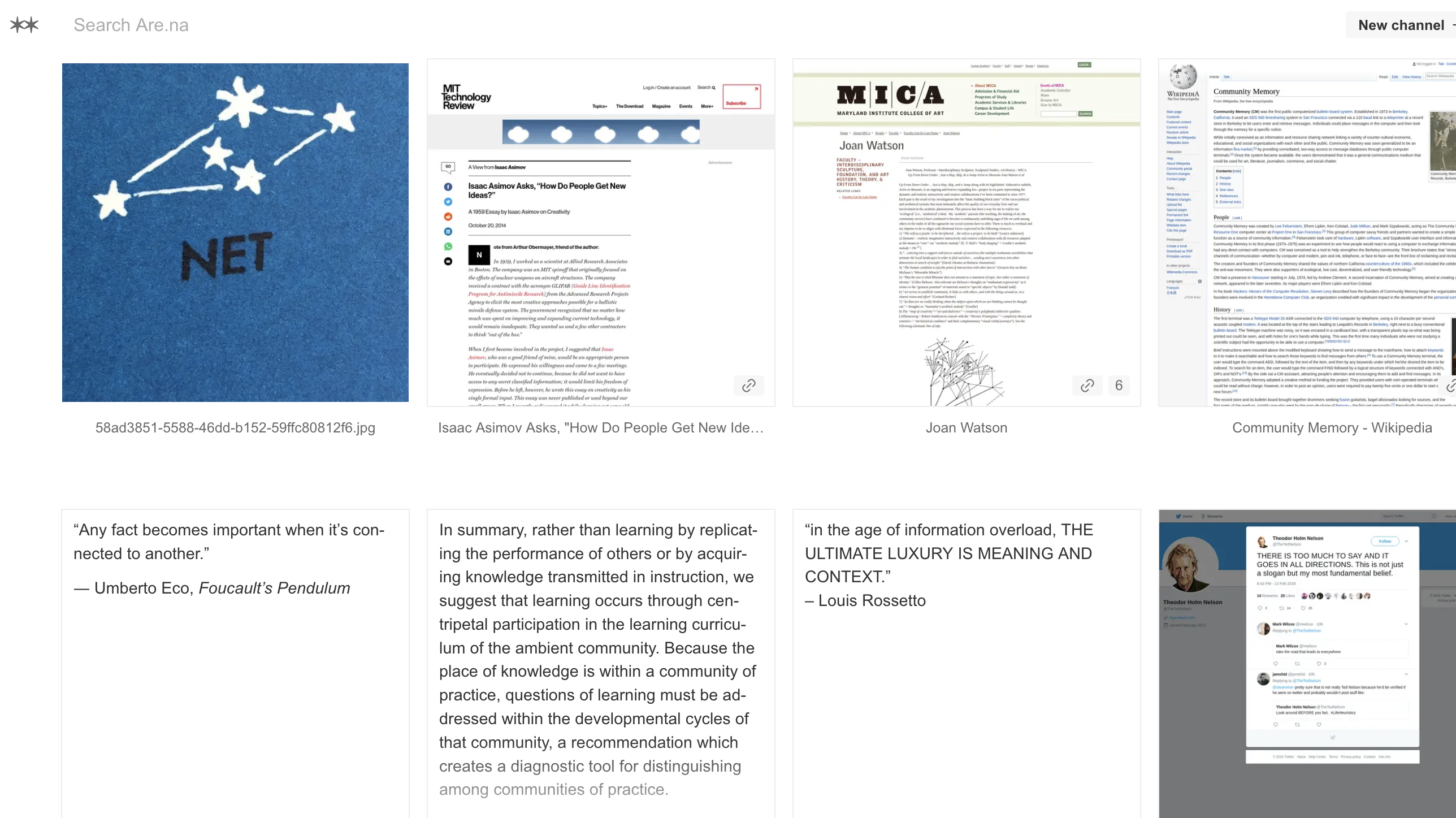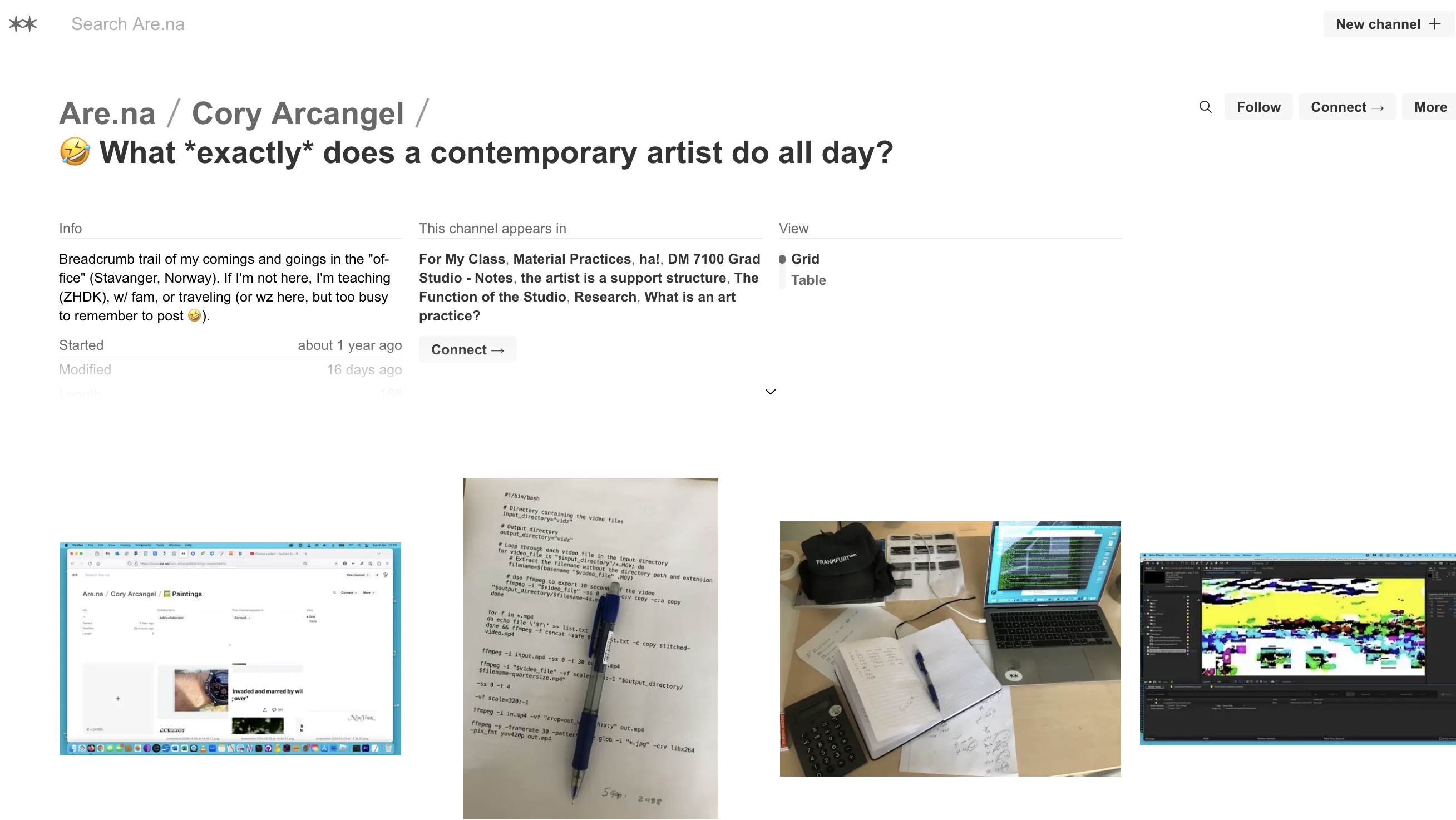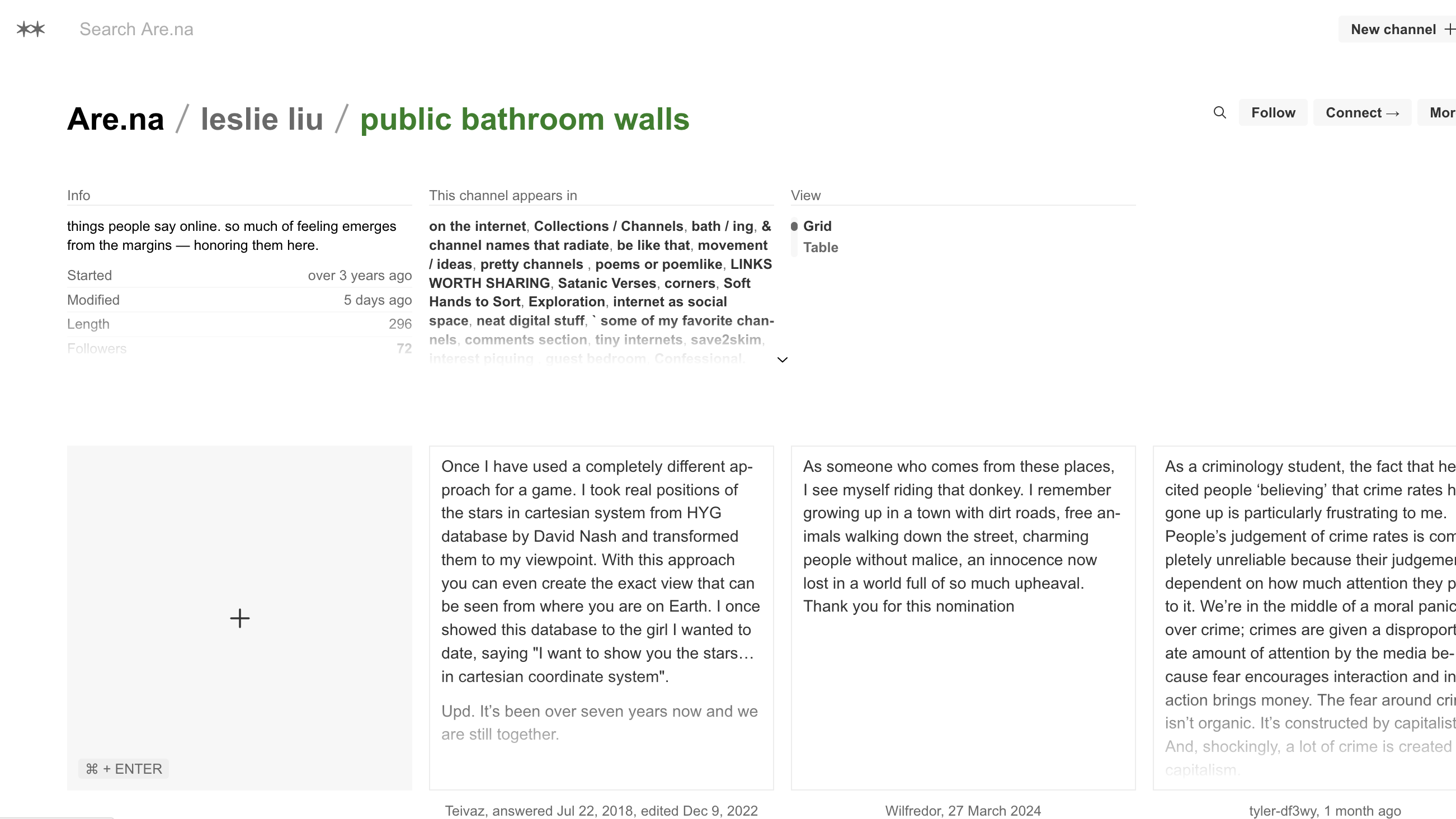Are.na is a platform where people save content and create collections, and it draws in mostly students, artists, designers and curious hobbyists with niche interests. Unlike the fast-paced, video-filled, instant and ephemeral feeds we see ourselves scrolling through mindlessly, Are.na offers a slow and, in co-founder Daniel Pianetti’s words, healthier way to consume and organise content online. In its blank canvas interface, you can combine the seemingly long-gone joyful randomness of the internet with deep research sources.
The Hmm’s Carolina sat down with Daniel to discuss how Are.na’s feeds, communities, and design shape its content and the way this platform contextualises and curates the internet. Would Are.na be able to give us our Perfect Feeds?
Carolina Valente Pinto: Hi Daniel, thank you for joining this conversation! For this research dossier, we’ve been looking at how information is organised on social media, on our digital platforms, throughout the last two decades. It went from chronological updates of what and how our friends are doing, to now the “for you” content, which is very algorithmically organised, as well as new things like stories and reels. As someone who’s worked in this field for years now, I was wondering, how do you see this change or phenomenon? Is this something that you reflect on, the change in how information comes to us through platforms?
Daniel Pianetti: It seems that a paradoxical thing happened, because if you see macro trends, there’s definitely an overwhelming feeling about feeds and notifications, people aren’t able to keep up with things and algorithmic suggestions. At the same time, if you look at younger and newer trends, everything is hyperspeed on TikTok and even on YouTube feeds. There are these two contrasting feelings and we, from our perspective, respond with our principle to make what our friends would use, and how we want to consume content. And that found some resonance in our audience, and we know we might not appeal to everyone. And some people might not realise right away that that’s a preferable way to consume, but once they try, they think “Oh, there’s actually a healthier way”. We never had the assumptions to impose the right or the wrong way. People can find their own way.
CVP: We were just talking about how you are trying to construct content in a healthier, perhaps, slower way, and also give agency to people to see their feed how they want. Besides this, what were some of the key decisions that shaped Are.na into how it is now? How has that evolved?
DP: Particularly related to the feed, we always want to give as much agency to the member as we can, but there’s always a fine line. If there’s too much agency, it gets–on the product side–complicated, and we are still a small operation. It also becomes overwhelming if you can choose too much. So there’s the question of how much you want to customise. But one thing that we saw resonating really well is giving very small tools. For example, a while ago, we introduced the possibility of hiding the notification counter. People might not want to see if there are new notifications, even if they’re there. And those small things, maybe they’re not appealing to a big, general group of users, but they’re appreciated. And it aligns with our vision. In the longer term, we definitely plan to allow more personalisation of the feed. For example muting more granularly, and things like that.

CVP: How do you think that these decisions and the ontological model of the website have dictated or shaped its content and the type of things people populate Are.na with?
DP: Well, one thing that wasn’t planned but came naturally has to do with the fact that Are.na’s feed and way to organise content brings out the desire in many people to use the randomness of browsing. Now that might not be very common, but it has been an inherent part of being online — just letting go, diving into the rabbit hole and seeing what it brings out. Not being fed with content encourages you to just get lost and find new connections in the unknown.
CVP: It makes it more like a blank canvas in a way, compared to other things that are more conditioned.
DP: We heard several times that people only use the Explore section of Are.na in random mode. And that’s something interesting.
CVP: The way I also see Are.na, as someone who uses and likes it, is that it is not just a website, but it becomes a sort of curatorial tool or platform. Already in 2017 there were articles about how Are.na is an “online tool for contextualising the Internet”, so it also produces discourses around online cultures. How was the transition from the main website to these other outputs that you have, like the Are.na Annual or the Sunday Reviews that end up curating something out of Are.na, which in itself curates the Internet?
DP: We always try to follow is to bring out the members of Are.na. So the Annual was one of the first decisions to incorporate: we have these very interesting people having interesting ideas, giving an interesting context to the internet. How do we highlight them, or give them an extra platform, an extra voice? The Annual and editorial blog was one of the first steps, and lately, we have been pushing that on the Gift Shop, so every new item is a specific collaboration with someone from the community, so we translate their curatorial interests. We try to follow that thread along with any external initiative.

CVP: Initiatives like the Annual really take the website out of its medium and frame, adding something else that people also feel ownership over, rather than being merely users. But Are.na also has a presence in regular social media. How do you see this relationship between these other projects, the website, and then the social media output? Is a social media presence just to bring people in? Or do you also take value from it?
DP: As for Twitter [X], we treat it just as a communication tool, so it is purely practical. And then obviously, we do get new subscriptions and new signups from Twitter, but it’s mostly other people talking about Are.na. And then Instagram, honestly, it’s been almost by accident. We never made any specific effort or advertising. It’s always a bit conflicting, we don’t enjoy using it. And we don’t get that many signups from it. People mostly just consume the images. I think any day we could decide to close it.
CVP: I can see how people enjoy following it for the aesthetics, and then it becomes a different kind of experience. But we were just talking about how you bring the members into all these other products and voices. And I enjoy how Are.na is purposefully positioning itself in an internet discourse, it’s very much part of the cultural sector. I don’t know how it differs per continent, at least this is my experience living in the Netherlands. The people who enjoy Are.na are working as designers, writers, curators or researchers. Was this something that you considered when you first started it, something that you wanted to cater to? Or was it that the approach brought these people, and then you went with it?
DP: I think it goes back to some of the personal interests and principles we had from the beginning; the Are.na Influences channel is a useful peek into that. But we never had the goal of becoming an entity in that sense. So that’s purely the natural course of things that were adopted and amplified by this community who have similar interests. There’s definitely a type of person who’s interested in Are.na across different continents. We would like to expand that; we always say that anyone could use Are.na. So we’re always interested to see when someone unexpectedly uses Are.na.

CVP: Maybe we can also go into how Are.na holds a bit of a slower pace. I think you mentioned the older models of the internet at the beginning of the conversation, in contrast with the TikTok attention / content spam. How do you think the Are.na model survives in the attention economy we live in today?
DP: In my personal view, I do believe in and I have a strong interest in anything that brings out authorship. I do think that, with the craze of algorithms and AI, authorship is going to have a new, strong value. So in that sense, it’s going to be different. It’s not going to be mainstream, but it’s not going to disappear.
CVP: What’s also really interesting is the choice of medium: as opposed to the TikTok content spam, Are.na prioritises non-video content, and also reclaims a bit of this “status update” that I mentioned in the beginning that happened more at the beginning of social media. There’s an example from artist Cory Arcangel that I was thinking about, he has a channel called “What exactly does a contemporary artist do all day?” and it has this randomness of the update, of daily life. How do you see that interaction between randomness and more research content on Are.na?
DP: I can’t tell what exactly is the connection, we see so many different uses of Are.na. Some people use it as a diary, some people very introspectively, as they have most of their channels private. So it’s hard to define this relation. And we like the fact that it’s a bit of a blank canvas, it can adapt to your lifestyle and the way you interact with the online world.

CVP: Before we wrap up, I was wondering, what’s your favourite Are.na channel at the moment?
DP: I have a few ones, but one of them is “public bathroom walls” – all the blocks are internet “wall writings”, there is only one actual bathroom writing as the exception. All blocks have a linked description to the original source. It’s things people say in chats and Youtube comments, for example.
CVP: Nice, thank you for sharing. And thank you for taking the time to talk to us.
